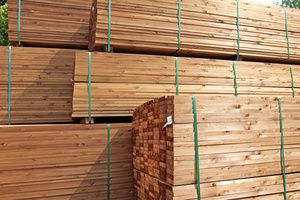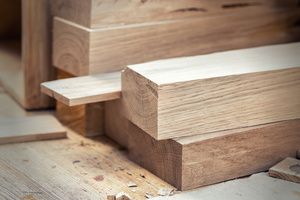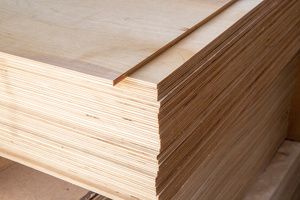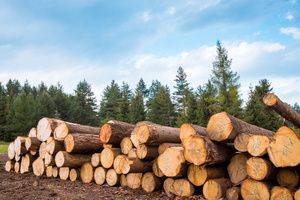Following is a quick reference of common terms used in the wholesale lumber industry. Becoming familiar with these terms will give you a better understanding of the lumber and plywood you buy, how these materials are manufactured and processed, and some of the factors that can influence price, strength and visual appeal.
Common Wholesale Lumber Terms
Air drying: The process of naturally drying lumber that leaves roughly 18% of its original moisture content.
Band saw: A power saw with a long, sharp continuous band of toothed metal that creates right-angle tooth markings on the face of lumber.
Birdseye: A figure on wood, generally found in maples. They create a mottled effect, resembling a bird’s eye.
Bleed: The rising of tannins to the surface of a cut of wood. Sometimes this isn’t noticeable, but it may also sometimes turn wood gray.

Board foot: The unit of measure used by sawmills and lumber suppliers to calculate the number of cubic inches of wood that can be taken from a log or the finished product. One board foot is equal to a piece of lumber that is 12 inches long, 12 inches wide and one inch thick.
Bow: Sometimes referred to as bowing, this is a lumber defect that causes warping along the length of the wood.
Burl: A swirl in the grain that isn’t a knot. Burled woods are considered to be higher in value due to their uniqueness.
Chatter marks: Bumpy surfaces on lumber.
Clear face cutting: A cutting with one clear face and the reverse side, sound.
CLF: A measurement for one hundred linear feet of lumber. “Centum” is Latin for “Hundred,” hence the acronym starting with “C.”
Cull: Lumber priced to sell quickly as it does not meet grading standards. It is still useful and can be used for certain projects.
Deciduous: Hardwood trees that shed leaves annually, such as walnut, oak, and ash.
Delamination: Separation of veneers in plywood when the adhesive fails.
Dunnage: Lumber used as packing material to keep cargo and freight secured in transit.
Face: The broad side of the board with the most surface.
FAS: Standing for “First and Second,” this is the highest grade of lumber. It still has some defects but is heavily used for furniture and cabinetry.
Fiberboard: A panel made from wood pulp or fiber held together with adhesive.
Flakeboard: Also known as particle boards, boards are composed of bonded wood flakes melded together with resin, heat, and pressure.
Framing lumber: The lumber used to create structural support in buildings and homes, to which floors, walls, and roofs are attached. Framing lumber grades: Dense Select Structural (DSS), Select Structural (SS), #1, #2, #3, Construction, Standard, Utility.
Furniture pine: Sometimes referred to as “Knotty” or “Premium” grade, and used for furniture, cabinetry, window frames, panels, and floors.
Grade: The value given to lumber or plywood indicating wood quality based on appearance and strength. Different grading scales are used for hardwoods and softwoods, and for lumber and plywood.
Grain: The pattern of wood fiber that is vertical to the lumber.
Green lumber: Fresh, unseasoned wood. Sometimes used to describe lumber with a moisture content of 30% or more.
Gross tally: The amount of board measured before the shrinkage that happens in kiln drying.

Hardwood: Wood from trees that lose leaves during the winter, such as oak, birch, walnut, and maple.
Heartwood: The central column of wood in tree trunks that is usually harder and darker than newer wood.
Improved wood: A type of lumber where hardwood veneers are soaked in resin that produces a heavier and more durable product than natural wood.
Janka Hardness Test: A test that measures the durability of wood against denting and wear. The test results determine the potential use for a type of wood, such as in flooring or utilities.
Kiln Dried After Treatment (KDAT): Indicates that the lumber or plywood has been dried in a kiln following its pressure treating process.
Kiln drying: A controlled process that dries fresh cut wood with heated air to uniformly reduce the moisture content to 18% or less. Hardwoods are usually dried down to 6% – 8%, with softwoods coming down to 9% – 12%. Woods with higher oil content will likely be dried more.
Landscape ties: Treated lumber used for retaining walls and landscaping.
LFE: An abbreviation of “low formaldehyde emission,” a classification of wood that emits lower quantities of formaldehyde, which occurs naturally in wood.
Lineal feet: A measurement unit for the length of boards. One lineal foot is equivalent to one foot or twelve inches.
Lumber: Logs that have been sawn, planed, and cut to specific lengths. There are many classifications of lumber depending on their use and appearance.
Machine Stress Rated (MSR): Softwood lumber that has been mechanically measured for strength against six design values: bending, shear parallel to grain, compression perpendicular to grain,compression parallel to grain, tension parallel to gain, and modulus of elasticity. MSR lumber is specified when critical design values must be met.
Milling: The processing of rough cut and surfaced lumber into standard thicknesses.
NHLA: National Hardwood Lumber Association, the governing and standardizing body of hardwood management.
Non-commercial species: Types of trees that do not produce wood suitable for consumer wood products such as furniture or building materials.
On-center: Sometimes abbreviated as “OC,” it is a method of measuring from the middle point of one board or post to the middle point of the next. Measuring from edges can cause structural insecurity later on.
Pitch: A natural resin substance seen commonly on firs and pines. These spots can create pockets that cause resin defects in wood rings.

Pith: The small, soft center of a tree.
Planed: A method of obtaining a smooth surface on cuts of wood.
Plywood: Sheets made from layers of veneers that are glued together in alternating grain directions to prevent shrinkage and warping.
Pressure treated: Wood infused with fire retardant or rot and pest resistant chemicals using a pressure impregnation process.
Random widths and lengths: Also designated as RW&L, this is a practice of cutting lumber to create a maximized yield, reducing waste. These pieces are randomized and allow for occasional defects.
Resawn: Wood that has been milled again just prior to purchase to brighten up the appearance.
Rough: Sometimes shortened to “Rgh,” it is a coarse lumber with a more natural look. These cuts usually need some sort of surfacing for a smooth finish.
Shrinkage: The amount of dimension lost after lumber has been dried.
Softwood: Softwood trees are conifers, or have needles and remain green all year long, such as spruces, firs, pines, and redwoods.
Sound: A board with little to no defects that will affect its durability or strength.
Square feet: The surface area of a project, calculated by multiplying the length by width. Sometimes referred to as the “surface measure” or “SM.”
Stain: A finishing product that colors wood through absorption of the stain. Also, a discoloration in lumber caused by natural processes such as decay or fungi.
Surfacing: Planing wood to create a smooth finish. Within surfacing, there are classifications such as: S2S is surfaced on two sides, S3S is surfaced on 3 sides, and S4S is surfaced on four.

Timber: A general term used to reference the forest and what it makes. Also, can refer to dimensional lumber exceeding 5″x5″.
Tolerance: The amount of allowable variation in dimensions and measurement.
Veneer: Thin sheets of wood that have been sliced or peeled to be glued together or onto a base material.
Warp: The distortion in wood caused by uneven absorption of moisture or, more often, when wood is dried unevenly, too quickly or too slowly. Applying finishes to only one side of the wood can also cause warping. Forms of warp include “bow,” “crook,” “cup”, “kink,” and “twist.”
Worm holes: Holes in wood caused by a type of worm that does not survive processing. WHAD designates “Worm holes, a defect,” and WHND designates “Worm holes, no defect.
Xylem: Bark’s cellular tissue, commonly referred to as wood.
Starting a New Project?
Curtis Lumber and Plywood, founded in 1957, is an independently owned and operated wholesale lumber and plywood distributor in Springfield, Virginia, that sells exclusively to leading lumber dealers throughout the mid-Atlantic region. Providing knowledge, experience, and resources to our community for 60 years.
If you are a retailer lumber dealer, contact Curtis Lumber & Plywood at a (703) 552-5778 visit us online today!

